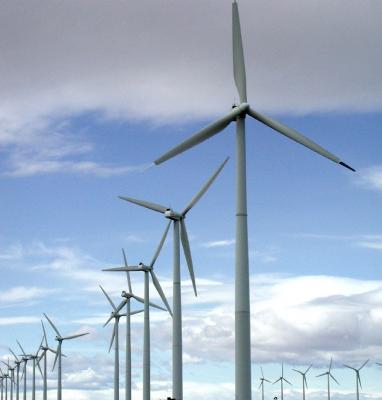As Canada awaits a decision on WPPI and anticipates 1,218 MW of 2006 installed capacity, the U.S. experiences record 2006 growth and faces the sunset of the PTC.
Editor’s note: Visit www.nawindpower.com for the most recent daily news affecting North America’s wind industry. NAW’s new Web site features printable and e-mailable daily news links and a searchable archive of wind news.

In its 2005 budget, the Canadian government committed to increasing the Wind Power Production Incentive (WPPI) program to a target of 4,000 MW from 1,000 MW. This increase stimulated several project proposals, such as Suncor Energy’s 30 MW Chin Chute wind power project near Taber, Alberta. WPPI, however, currently is under review by the new conservative Canadian government, and it is not clear whether program approvals will begin in the near future.
It is possible that initial WPPI program incentives of about C$0.01 per kWh may not be approved for new wind projects such as Chin Chute – a decision that could reduce estimated project earnings and cause performance penalties.
In his opening remarks at the Canadian Wind Energy Association’s (CanWEA) 2006 conference and tradeshow in Winnipeg, Canada, Robert Hornung, president of CanWEA, stressed the importance of WPPI in maintaining the strong growth Canada’s wind industry has experienced.
“More than $2 billion in project contracts were signed after the 2005 budget assuming WPPI would be available,” Hornung said. “The absence of WPPI would fundamentally and negatively change project economics and send a negative signal to investors and provincial governments about the Canadian market.”
Canada’s wind industry expects to end 2006 with more than 700 MW of new projects installed. “This means Canada’s total installed wind energy capacity will have doubled from the end of 2005 to the end of 2006,” Hornung added. Windlogics
In addition, Hornung reported to CanWEA attendees that there are more than 2,800 MW of projects under either construction or contract, including 1,244 MW in Quebec, 959 MW in Ontario, 325 MW in British Columbia, 164 MW in Alberta and 73 MW in Nova Scotia.
Although the support of the federal government and the WPPI program are critical to growth in Canada’s wind energy sector, provincial governments have taken steps to ensure growth through renewable portfolio standards, renewable and wind energy procurement targets, and standard offer contracts.
Provincial wind energy objectives for 2015 would bring Canada’s installed wind energy capacity to more than 7,355 MW. Current provincial wind energy objectives include:
– 4,000 MW in Quebec
– 1,000 MW in Manitoba
– 900 MW in Alberta
– 400 MW in New Brunswick
– 380 MW in Nova Scotia
– 325 MW in British Columbia
– 200 MW in Prince Edward Island, and
– 150 MW in Newfoundland.
In addition, Ontario has established a goal of 2,700 MW of renewable capacity by 2010, which would push Canada’s combined wind and other renewables objectives to 10,055 MW.
In his presentation to CanWEA attendees, Hornung said certain stumbling blocks still exist that could hinder Canada’s ability to meet or exceed its 10,000 MW capacity objectives. Among these obstacles, which include policy, grid, economic and communications challenges, Hornung noted that, “In some jurisdictions [e.g., Ontario], limits on transmission capacity are emerging as a significant barrier to wind energy development.”
Growth of transmission in conjunction with renewable generation is an issue felt in the U.S. energy sector as well. The American Wind Energy Association (AWEA) noted in its third-quarter report that AWEA has filed comments with the U.S. Department of Energy on the “need for national interest transmission corridors to unlock the vast wind resources of the American heartland.”
According to AWEA’s report, the U.S. wind energy industry is paralleling Canada’s wind industry in both significant growth and policy challenges. Not only is the U.S. wind power industry set to install a record 2,700 MW of generating capacity in 2006, but FPL Energy officially opened its 735 MW Horse Hollow Wind Energy Center, which is the world’s largest wind farm to date.
A total of 1,345 MW already has been completed in the U.S. in 2006, according to AWEA, bringing total installed wind energy capacity to 10,492 MW. In addition, construction is proceeding on an additional 1,500 MW of wind farms to be completed this year.
However, ongoing growth of this magnitude in the wind power sector is uncertain as the U.S. wind energy production tax credit (PTC), which received a two-year extension in the Energy Policy Act, expires in December 2007.
“The U.S. wind industry is working all-out to meet current demand for new wind farms,” said Randall Swisher, executive director of AWEA. “But the nation needs a timely and long-term extension of the wind energy PTC to allow companies to plan beyond 2007 and continue to build a strong and secure energy future.”
Hallo, but topic starter, you are sure?
prof.Preobrajensky.
Bye
Am I sure of what exactly?